Emission Flux Measurement Error with a Mobile DOAS System and Application to NOx Flux Observations
Abstract
:1. Introduction
2. Experiment and Principles
2.1. Overview of Experiment
2.2. Mobile DOAS System
2.3. Principle of Mobile DOAS
2.3.1. Retrieval of Vertical Column Density
2.3.2. Estimation of Emission
2.4. Data Analysis
3. Analysis of Mobile DOAS Error
3.1. Usage of Driving Speed
3.2. Usage of Wind
3.3. Comparison of SO2 Emission Using Different Wind Data
3.4. Total Errors of Emission Flux
3.5. Emission Estimation of NOx
4. Conclusions
Acknowledgments
Author Contributions
Conflicts of Interest
References
- Lei, W.; de Foy, B.; Zavala, M.; Volkamer, R.; Molina, L.T. Characterizing Ozone Production in the Mexico City Metropolitan Area: A Case Study Using A Chemical Transport Model. Atmos. Chem. Phys. 2007, 7, 1347–1366. [Google Scholar] [CrossRef]
- Zheng, J.Y.; Zhang, L.J.; Che, W.W.; Zheng, Z.Y.; Yin, S.S. A highly resolved temporal and spatial air pollutant emission inventory for the Pearl River Delta region, China and its uncertainty assessment. Atmos. Environ. 2009, 43, 5112–5122. [Google Scholar] [CrossRef]
- Johansson, M.; Galle, B.; Yu, T.; Tang, L.; Chen, D.L.; Li, H.J.; Li, J.X.; Zhang, Y. Quantification of total emission of air pollutants from Beijing using mobile mini-DOAS. Atmos. Environ. 2008, 42, 6926–6933. [Google Scholar] [CrossRef]
- Johansson, M.; Rivera, C.; de Foy, B.; Lei, W.; Song, J.; Zhang, Y.; Galle, B.; Molina, L. Mobile mini-DOAS measurement of the outflow of NO2 and HCHO from Mexico City. Atmos. Chem. Phys. 2009, 9, 5647–5653. [Google Scholar] [CrossRef]
- Galle, B.; Oppenheimer, C.; Geyer, A.; McGonigle, A.J.S.; Edmonds, M.; Horrocks, L. A miniaturised ultraviolet spectrometer for remote sensing of SO2 fluxes: A new tool for volcano surveillance. J. Volcanol. Geother. Res. 2003, 119, 241–254. [Google Scholar] [CrossRef]
- Rivera, C.; Sosa, G.; Wohrnschimmel, H.; De Foy, B.; Johansson, M.; Galle, B. Tula industrial complex (Mexico) emissions of SO2 and NO2 during the MCMA 2006 field campaign using a mobile mini-DOAS system. Atmos. Chem. Phys. 2009, 9, 6351–6361. [Google Scholar] [CrossRef]
- Ibrahim, O.; Shaiganfar, R.; Sinreich, R.; Stein, T.; Platt, U.; Wagner, T. Car MAX-DOAS measurements around entire cities: Quantification of NOx emissions from the cities of Mannheim and Ludwigshafen (Germany). Atmos. Meas. Tech. 2010, 3, 709–721. [Google Scholar] [CrossRef]
- Shaiganfar, R.; Beirle, S.; Sharma, M.; Chauhan, A.; Singh, R.P.; Wagner, T. Estimation of NOx emissions from Delhi using Car MAX-DOAS observations and comparison with OMI satellite data. Atmos. Chem. Phys. 2011, 11, 10871–10887. [Google Scholar] [CrossRef]
- Elsayed, N.M. Toxicity of nitrogen dioxide: An introduction. Toxicology 1994, 89, 161–174. [Google Scholar] [CrossRef]
- Jacob, D.J. Introduction to Atmospheric Chemistry; Princeton University Press: Princeton, NJ, USA, 1999. [Google Scholar]
- Seinfeld, J.H.; Pandis, S.N. From Air Pollution to Climate Change. Atmospheric Chemistry and Physics, 2nd ed.; John Wiley & Sons: New York, NY, USA, 2006. [Google Scholar]
- Li, A.; Xie, P.H.; Liu, W.Q. Monitoring of Total Emission Volume from Pollution Sources Based on Passive Differential Optical Absorption Spectroscopy. Acta Opt. Sin. 2007, 27, 1537–1542. (In Chinese) [Google Scholar]
- Wu, F.C.; Xie, P.H.; Li, A.; Chan, K.L.; Hartl, A.; Wang, Y.; Si, F.Q.; Zeng, Y.; Qin, M.; Xu, J.; et al. Observations of SO2 and NO2 by mobile DOAS in the Guangzhou eastern area during the Asian Games 2010. Atmos. Meas. Tech. 2013, 6, 2277–2292. [Google Scholar] [CrossRef]
- Constantin, D.-E.; Merlaud, A.; van Roozendael, M.; Voiculescu, M.; Fayt, C.; Hendrick, F.; Pinardi, G.; Georgescu, L. Measurements of Tropospheric NO2 in Romania Using a Zenith-Sky Mobile DOAS System and Comparisons with Satellite Observations. Sensors 2013, 13, 3922–3940. [Google Scholar] [CrossRef] [PubMed]
- Xu, J.; Xie, P.-H.; Si, F.-Q.; Li, A.; Wu, F.-C.; Wang, Y.; Liu, J.-G.; Liu, W.Q.; Hartl, A.; Lok, C.K. Observation of tropospheric NO2 by airborne multi-axis differential optical absorption spectroscopy in the Pearl River Delta region, south China. Chin. Phys. B 2014, 23, 9094210. [Google Scholar]
- Wang, T.; Hendrick, F.; Wang, P.; Tang, G.; Clémer, K.; Yu, H.; Fayt, C.; Hermans, C.; Gielen, C.; Müller, J.F.; et al. Evaluation of tropospheric SO2 retrieved from MAX-DOAS measurements in Xianghe, China. Atmos. Chem. Phys. 2014, 14, 11149–11164. [Google Scholar] [CrossRef]
- Strong, K.; Bailak, G.; Barton, D.; Bassford, M.; Blatherwick, R.; Brown, S.; Chartrand, D.; Davies, J.; Fogal, P.; Forsberg, E.; et al. Mantra—A balloon mission to study the odd-nitrogen budget of the stratosphere. Atmos. Ocean 2005, 43, 283–299. [Google Scholar] [CrossRef]
- Merlaud, A.; van Roozendael, M.; van Gent, J.; Fayt, C.; Maes, J.; Toledo-Fuentes, X.; Ronveaux, O.; de Mazière, M. DOAS measurements of NO2 from an ultralight aircraft during the Earth Challenge expedition. Atmos. Meas. Tech. 2012, 5, 2057–2068. [Google Scholar] [CrossRef]
- Schreier, S.F.; Peters, E.; Richter, A.; Lampel, J.; Wittrock, F.; Burrows, J.P. Ship-based MAX-DOAS measurements of tropospheric NO2 and SO2 in the South China and Sulu Sea. Atmos. Environ. 2015, 102, 331–343. [Google Scholar] [CrossRef]
- Platt, U.; Stutz, J. Differential Optical Absorption Spectroscopy: Principles and Applications; Springer: Heidelberg, Germany, 2008. [Google Scholar]
- Honninger, G.; von Friedeburg, C.; Platt, U. Multi axis differential optical absorption spectroscopy (MAX-DOAS). Atmos. Chem. Phys. 2004, 4, 231–254. [Google Scholar] [CrossRef]
- Lin, J.T.; McElroy, M.B.; Boersma, K.F. Constraint of anthropogenic NOx emissions in China from different sectors: A new methodology using multiple satellite retrievals. Atmos. Chem. Phys. 2010, 10, 63–78. [Google Scholar] [CrossRef]
- Bogumil, K.; Orphal, J.; Homann, T.; Voigt, S.; Spietz, P.; Fleischmann, O.C.; Vogel, A.; Hartmann, M.; Kromminga, H.; Bovensmann, H.; et al. Measurements of molecular absorption spectra with the SCIAMACHY preflight model: Instrument characterization and reference data for atmospheric remote-sensing in the 230–2380 nm region. J. Photoch. Photobiol. A 2003, 157, 167–184. [Google Scholar] [CrossRef]
- Kraus, S. DOASIS. A Framework Design for DOAS. Ph.D. Thesis, University of Mannheim, Shaker Verlag, Heidelberg, Germany, 2006. [Google Scholar]
- Kurucz, R.L.; Furenlid, I.; Brault, J.; Testerman, L. Solar Flux Atlas from 296 nm to 1300 nm, National Solar Observatory Atlas No. 1; Office of University Publisher, Harvard University: Cambridge, MA, USA, 1984. [Google Scholar]
- Van Roozendael, C.F. WinDOAS 2.1 Software User Manual; IASB/BIRA: Brussel, Belgium, 2001. [Google Scholar]
- Tim, D.; Steffen, B.; Udo, F.; Michael, G.; Christoph, K.; Lena, K.; Ulrich, P.; Cristina, P.-R.; Janis, P.; Thomas, W.; et al. The Monte Carlo atmospheric radiative transfer model McArtim: Introduction and validation of Jacobians and 3D features. J. Quant. Spectrosc. Radiat. Transf. 2011, 112, 1119–1137. [Google Scholar]
- Yang, J.; Li, A.; Xie, P.; Liu, W.; Wu, F.; Wang, Y.; Zeng, Y. The Application of MM5 Wind Data in Monitoring of Regional Pollution based on Passive DOAS under different Atmospheric Stability Conditions in China. In Proceedings of the 2nd International Conference on Remote Sensing, Environment and Transportation Engineering, Nanjing, China, 1–3 January 2012; Volume 5.
- Sun, N. The Research of Atmospheric Stability and Hoist Height in Zhenjiang. Master’s Thesis, Jiangsu University, Zhenjiang, China, 2007. [Google Scholar]
- Pasquill, F.; Smith, F.B. Atmospheric Diffusion, 2nd ed.; Ellis Horwood Limited: London, UK, 1983. [Google Scholar]
- Sutherland, R.A.; Hansen, F.V.; Bach, W.D. A quantitative method for estimating Pasquill stability class from windspeed and sensible heat flux density. Bound. Layer Meteorol. 1986, 37, 357–369. [Google Scholar] [CrossRef]
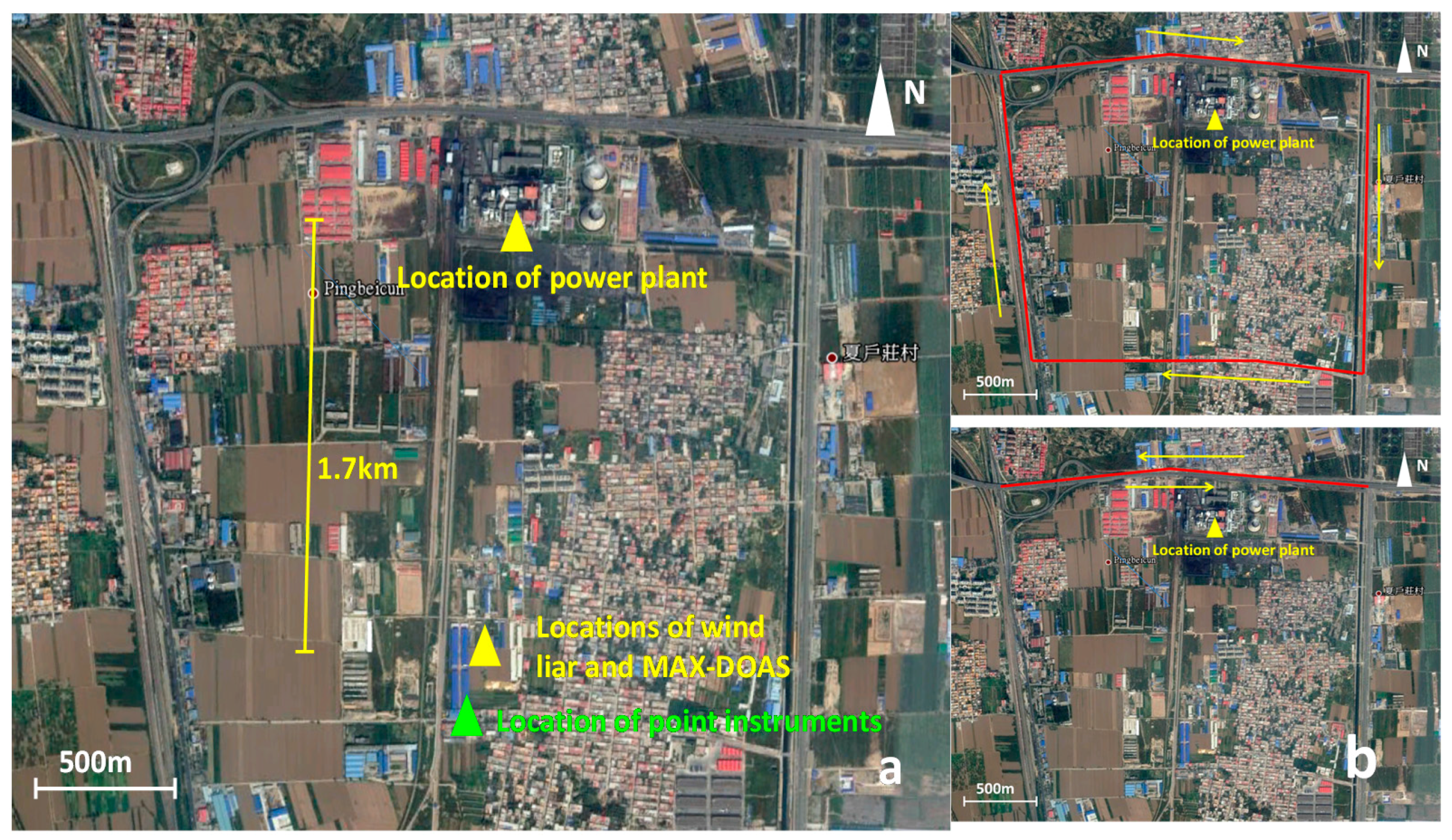

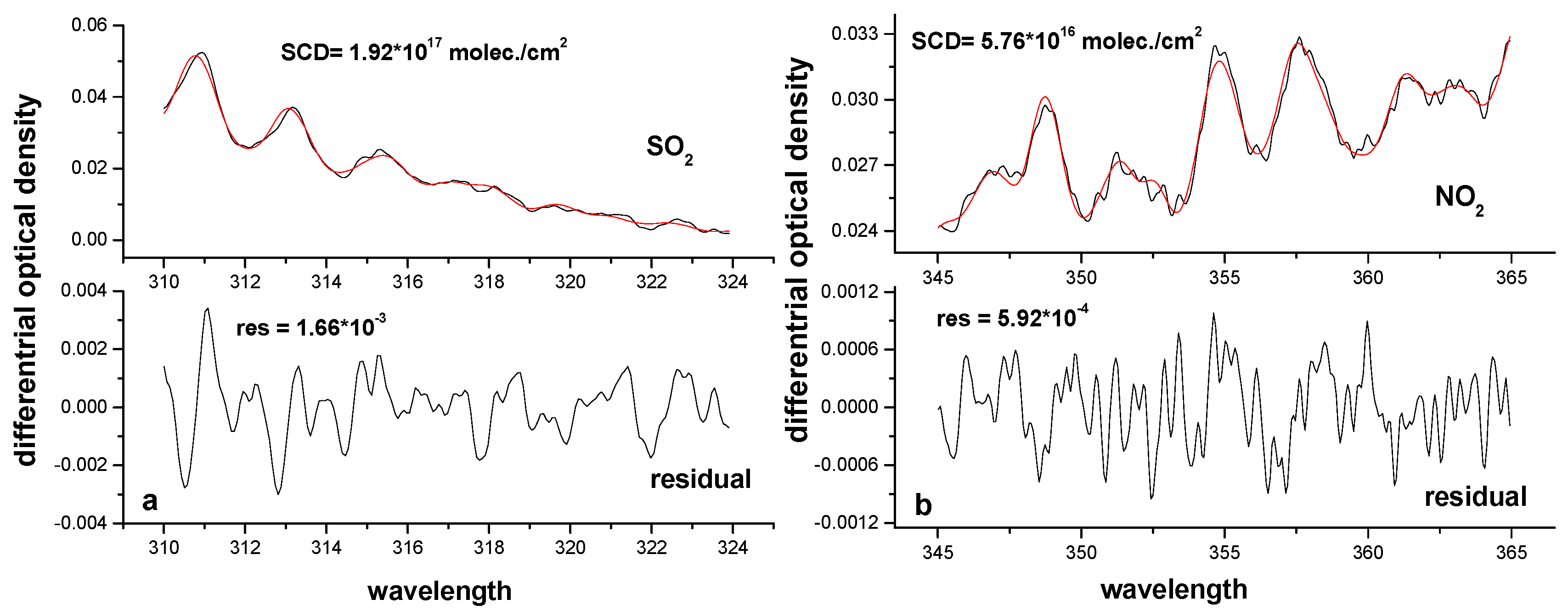

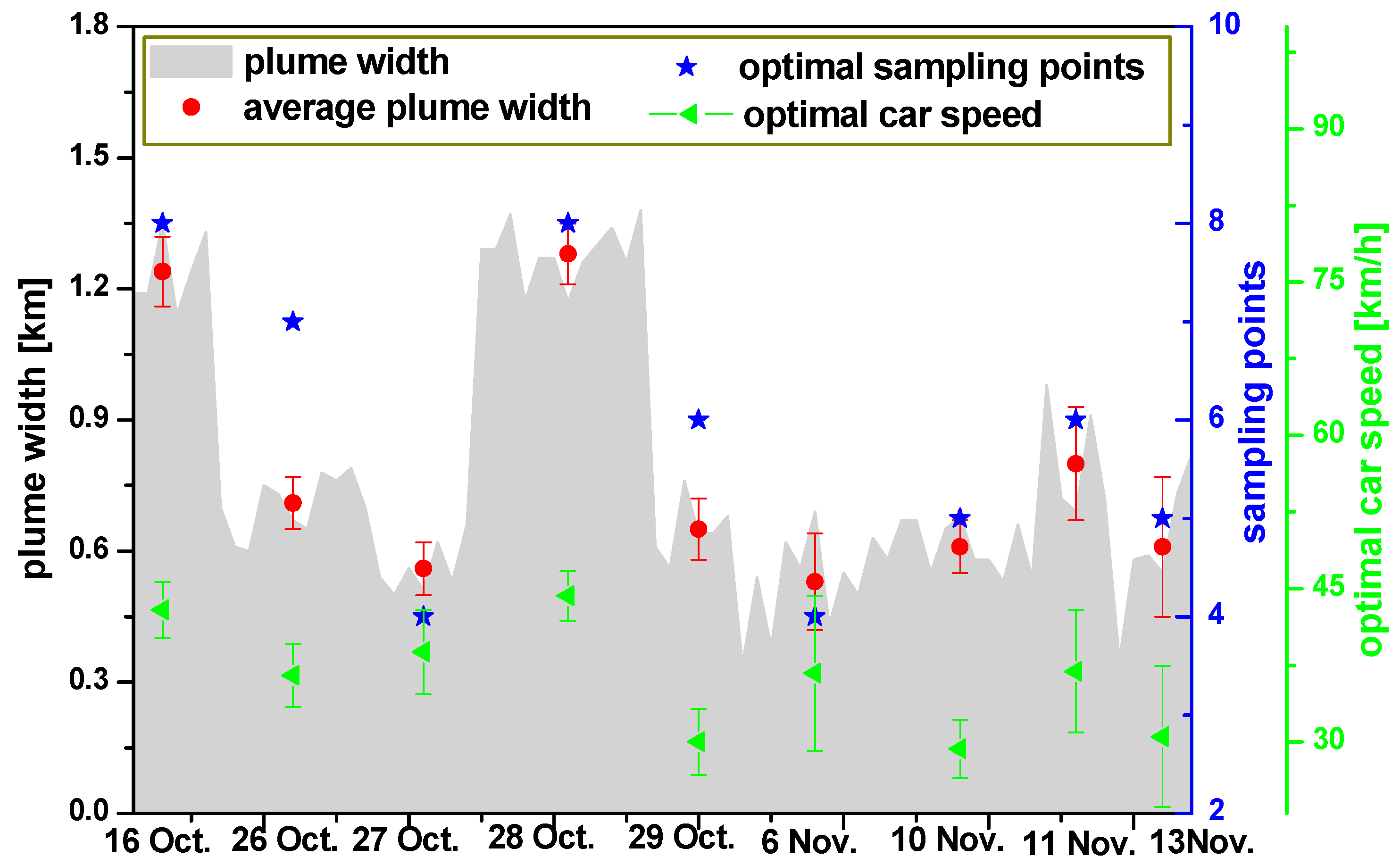
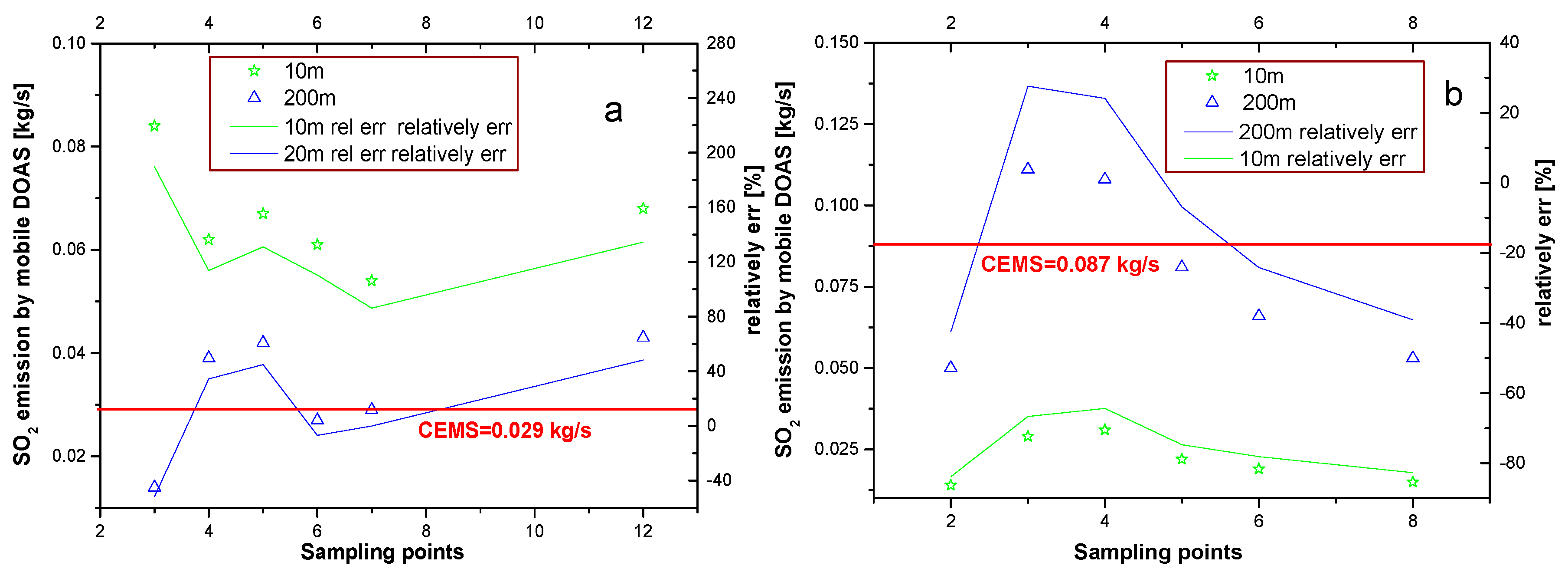

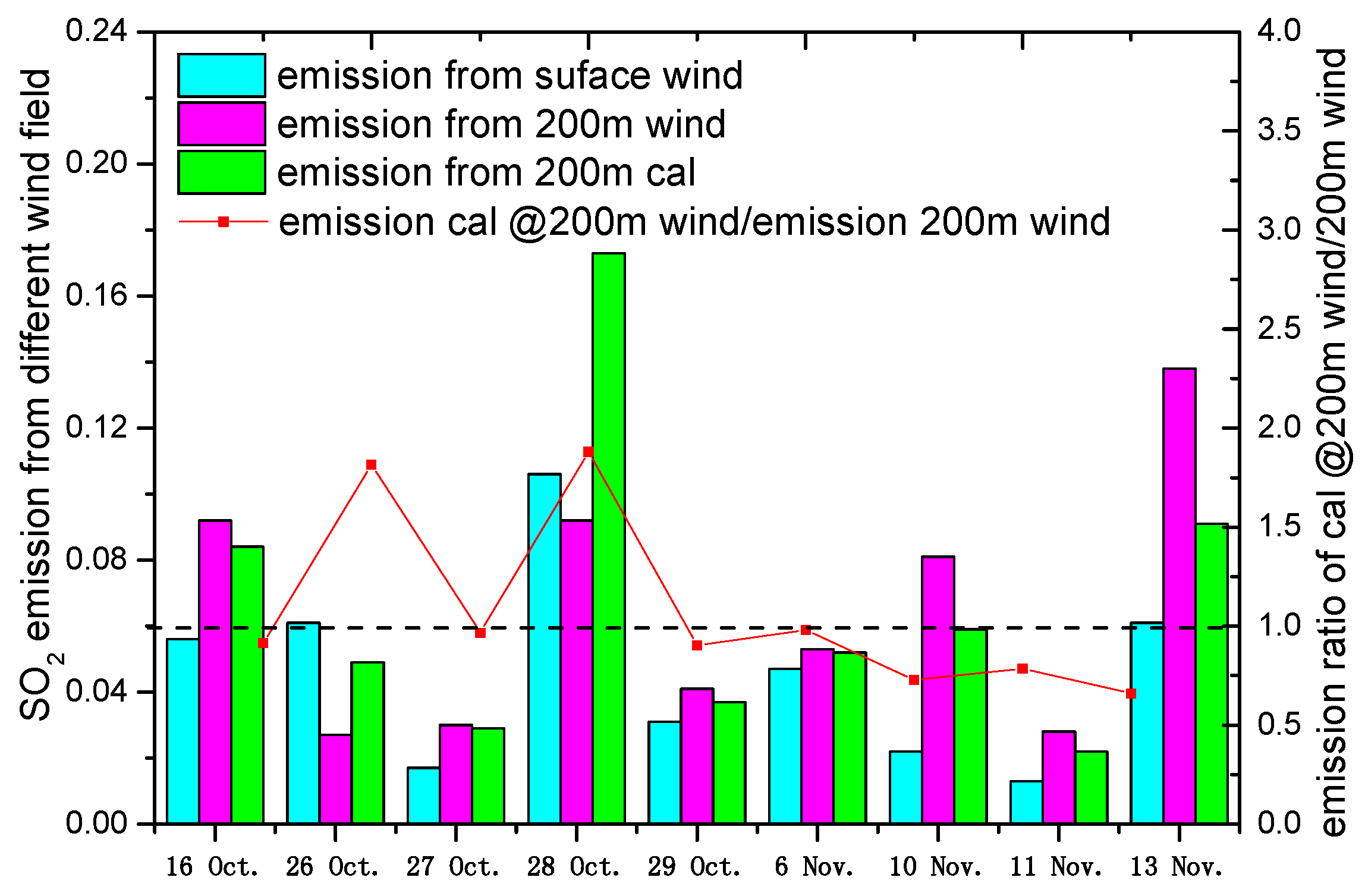
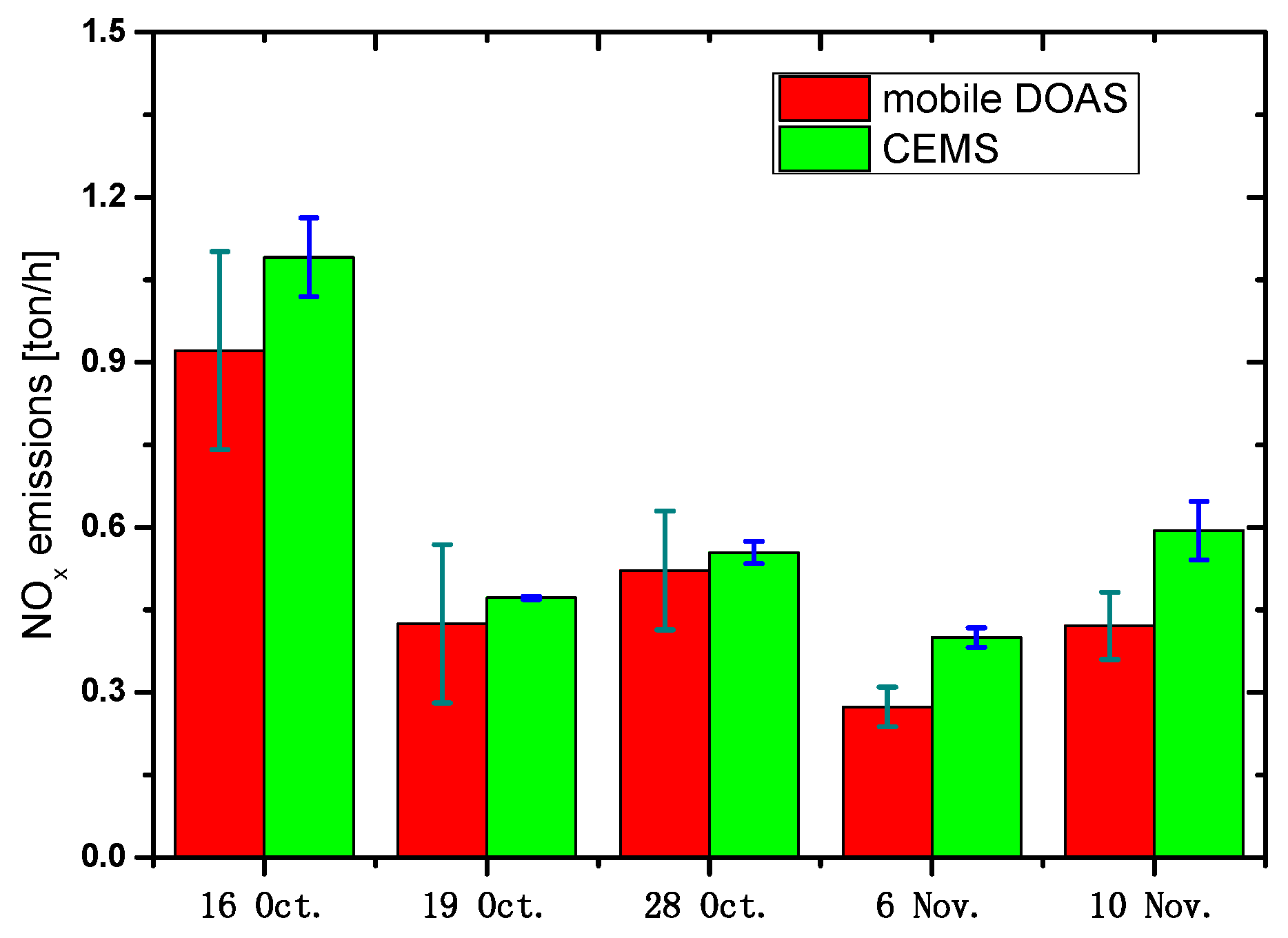
| Emission from CEMS kg/s | Surface Wind % | 200 m Wind % | Calculation at 200 m Wind % | |
|---|---|---|---|---|
| 16 October | 0.096 | −41.67 | −4.17 | −12.50 |
| 26 October | 0.029 | 110.34 | −6.90 | 68.97 |
| 27 October | 0.042 | −59.52 | −28.57 | −30.95 |
| 28 October | 0.069 | 53.62 | 33.33 | 150.72 |
| 29 October | 0.139 | −77.70 | −70.50 | −73.38 |
| 6 November | 0.064 | −26.56 | −17.19 | −18.75 |
| 10 November | 0.087 | −74.71 | −6.90 | −32.18 |
| 11 November | 0.056 | −76.79 | −50.00 | −60.71 |
| 13 November | 0.119 | −48.74 | −15.97 | −23.53 |
| Date | Time | Wind Direction (Degree) | Wind Speed (m/s) | Uncertainties from Wind Direction | Uncertainties from Wind Speed | Uncertainties from Wind |
|---|---|---|---|---|---|---|
| 16 October | 10:00–12:00 | 274.13 ± 2.15 | 1.81 ± 0.4 | 1% | 22% | 22% |
| 26 October | 12:30–14:00 | 135.25 ± 9.51 | 2.17 ± 0.2 | 14% | 10% | 17% |
| 27 October | 12:00–13:00 | 123 ± 6 | 1.9 ± 0.3 | 19% | 14% | 24% |
| 28 October | 11:40–13:00 | 183.02 ± 10.10 | 2.74 ± 0.42 | 2% | 15% | 16% |
| 29 October | 13:30–14:10 | 112.21 ± 1.81 | 2.92 ± 0.36 | 10% | 12% | 16% |
| 6 November | 11:00–13:00 | 230.8 ± 12 | 2.03 ± 0.64 | 24% | 33% | 41% |
| 10 November | 13:00–14:30 | 167.67 ± 9.46 | 2.33 ± 0.54 | 3% | 24% | 25% |
| 11 November | 11:30–12:10 | 211.17 ± 28.06 | 1.05 ± 0.29 | 33% | 29% | 44% |
| 13 November | 11:40–12:10 | 192.58 ± 7.29 | 2.66 ± 0.61 | 3% | 23% | 24% |
| Date | NO mg/m3 | NO2 mg/m3 | Leighton Ratio | O3 mg/m3 | R | CL | Wind Speed m/s |
|---|---|---|---|---|---|---|---|
| 16 October | 0.041 | 0.072 | 0.57 | 0.042 | 1.57 | 1.06 | 1.81 |
| 19 October | 0.014 | 0.041 | 0.34 | 0.024 | 1.34 | 1.04 | 3.00 |
| 28 October | 0.04 | 0.116 | 0.34 | 0.048 | 1.34 | 1.06 | 2.74 |
| 6 November | 0.015 | 0.044 | 0.34 | 0.048 | 1.34 | 1.07 | 2.03 |
| 10 November | 0.028 | 0.063 | 0.44 | 0.028 | 1.44 | 1.05 | 2.33 |
© 2017 by the authors. Licensee MDPI, Basel, Switzerland. This article is an open access article distributed under the terms and conditions of the Creative Commons Attribution (CC BY) license ( http://creativecommons.org/licenses/by/4.0/).
Share and Cite
Wu, F.; Li, A.; Xie, P.; Chen, H.; Hu, Z.; Zhang, Q.; Liu, J.; Liu, W. Emission Flux Measurement Error with a Mobile DOAS System and Application to NOx Flux Observations. Sensors 2017, 17, 231. https://doi.org/10.3390/s17020231
Wu F, Li A, Xie P, Chen H, Hu Z, Zhang Q, Liu J, Liu W. Emission Flux Measurement Error with a Mobile DOAS System and Application to NOx Flux Observations. Sensors. 2017; 17(2):231. https://doi.org/10.3390/s17020231
Chicago/Turabian StyleWu, Fengcheng, Ang Li, Pinhua Xie, Hao Chen, Zhaokun Hu, Qiong Zhang, Jianguo Liu, and Wenqing Liu. 2017. "Emission Flux Measurement Error with a Mobile DOAS System and Application to NOx Flux Observations" Sensors 17, no. 2: 231. https://doi.org/10.3390/s17020231






